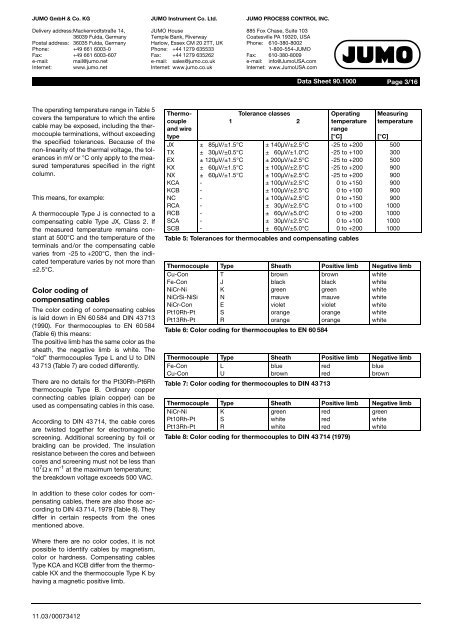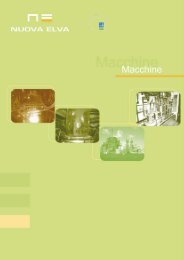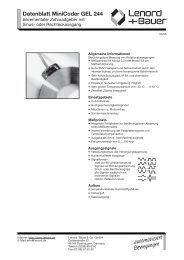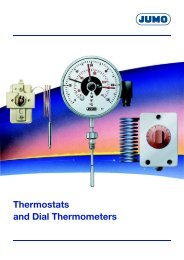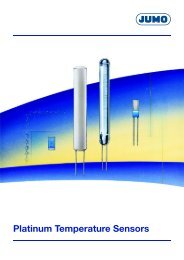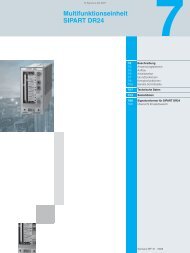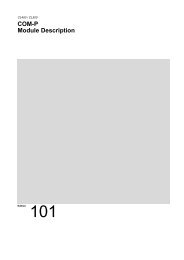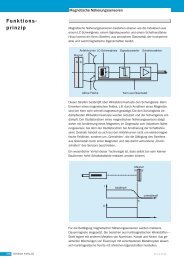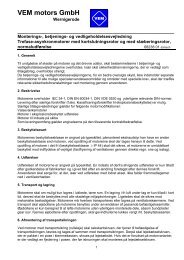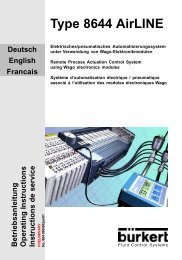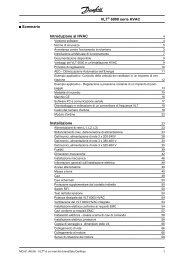Thermocouples - Nuova Elva
Thermocouples - Nuova Elva
Thermocouples - Nuova Elva
Create successful ePaper yourself
Turn your PDF publications into a flip-book with our unique Google optimized e-Paper software.
JUMO GmbH & Co. KG<br />
Delivery address:Mackenrodtstraße 14,<br />
36039 Fulda, Germany<br />
Postal address: 36035 Fulda, Germany<br />
Phone: +49 661 6003-0<br />
Fax: +49 661 6003-607<br />
e-mail: mail@jumo.net<br />
Internet: www.jumo.net<br />
JUMO Instrument Co. Ltd.<br />
JUMO House<br />
Temple Bank, Riverway<br />
Harlow, Essex CM 20 2TT, UK<br />
Phone: +44 1279 635533<br />
Fax: +44 1279 635262<br />
e-mail: sales@jumo.co.uk<br />
Internet: www.jumo.co.uk<br />
JUMO PROCESS CONTROL INC.<br />
885 Fox Chase, Suite 103<br />
Coatesville PA 19320, USA<br />
Phone: 610-380-8002<br />
1-800-554-JUMO<br />
Fax: 610-380-8009<br />
e-mail: info@JumoUSA.com<br />
Internet: www.JumoUSA.com<br />
Data Sheet 90.1000<br />
Page 3/16<br />
The operating temperature range in Table 5<br />
covers the temperature to which the entire<br />
cable may be exposed, including the thermocouple<br />
terminations, without exceeding<br />
the specified tolerances. Because of the<br />
non-linearity of the thermal voltage, the tolerances<br />
in mV or °C only apply to the measured<br />
temperatures specified in the right<br />
column.<br />
This means, for example:<br />
A thermocouple Type J is connected to a<br />
compensating cable Type JX, Class 2. If<br />
the measured temperature remains constant<br />
at 500°C and the temperature of the<br />
terminals and/or the compensating cable<br />
varies from -25 to +200°C, then the indicated<br />
temperature varies by not more than<br />
±2.5°C.<br />
Color coding of<br />
compensating cables<br />
The color coding of compensating cables<br />
is laid down in EN 60 584 and DIN 43 713<br />
(1990). For thermocouples to EN 60 584<br />
(Table 6) this means:<br />
The positive limb has the same color as the<br />
sheath, the negative limb is white. The<br />
“old” thermocouples Type L and U to DIN<br />
43 713 (Table 7) are coded differently.<br />
There are no details for the Pt30Rh-Pt6Rh<br />
thermocouple Type B. Ordinary copper<br />
connecting cables (plain copper) can be<br />
used as compensating cables in this case.<br />
According to DIN 43 714, the cable cores<br />
are twisted together for electromagnetic<br />
screening. Additional screening by foil or<br />
braiding can be provided. The insulation<br />
resistance between the cores and between<br />
cores and screening must not be less than<br />
10 7 Ω xm -1 at the maximum temperature;<br />
the breakdown voltage exceeds 500 VAC.<br />
Thermocouple<br />
and wire<br />
type<br />
JX<br />
TX<br />
EX<br />
KX<br />
NX<br />
KCA<br />
KCB<br />
NC<br />
RCA<br />
RCB<br />
SCA<br />
SCB<br />
± 85µV/±1.5°C<br />
± 30µV/±0.5°C<br />
± 120µV/±1.5°C<br />
± 60µV/±1.5°C<br />
± 60µV/±1.5°C<br />
-<br />
-<br />
-<br />
-<br />
-<br />
-<br />
-<br />
Tolerance classes<br />
1 2<br />
± 140µV/±2.5°C<br />
± 60µV/±1.0°C<br />
± 200µV/±2.5°C<br />
± 100µV/±2.5°C<br />
± 100µV/±2.5°C<br />
± 100µV/±2.5°C<br />
± 100µV/±2.5°C<br />
± 100µV/±2.5°C<br />
± 30µV/±2.5°C<br />
± 60µV/±5.0°C<br />
± 30µV/±2.5°C<br />
± 60µV/±5.0°C<br />
Table 5: Tolerances for thermocables and compensating cables<br />
Table 6: Color coding for thermocouples to EN 60 584<br />
Table 7: Color coding for thermocouples to DIN 43 713<br />
Operating<br />
temperature<br />
range<br />
[°C]<br />
-25 to +200<br />
-25 to +100<br />
-25 to +200<br />
-25 to +200<br />
-25 to +200<br />
0to+150<br />
0to+100<br />
0to+150<br />
0to+100<br />
0to+200<br />
0to+100<br />
0to+200<br />
Table 8: Color coding for thermocouples to DIN 43 714 (1979)<br />
Measuring<br />
temperature<br />
[°C]<br />
500<br />
300<br />
500<br />
900<br />
900<br />
900<br />
900<br />
900<br />
1000<br />
1000<br />
1000<br />
1000<br />
Thermocouple Type Sheath Positive limb Negative limb<br />
Cu-Con<br />
Fe-Con<br />
NiCr-Ni<br />
NiCrSi-NiSi<br />
NiCr-Con<br />
Pt10Rh-Pt<br />
Pt13Rh-Pt<br />
T<br />
J<br />
K<br />
N<br />
E<br />
S<br />
R<br />
brown<br />
black<br />
green<br />
mauve<br />
violet<br />
orange<br />
orange<br />
brown<br />
black<br />
green<br />
mauve<br />
violet<br />
orange<br />
orange<br />
white<br />
white<br />
white<br />
white<br />
white<br />
white<br />
white<br />
Thermocouple Type Sheath Positive limb Negative limb<br />
Fe-Con<br />
L<br />
blue<br />
red<br />
blue<br />
Cu-Con<br />
U<br />
brown<br />
red<br />
brown<br />
Thermocouple Type Sheath Positive limb Negative limb<br />
NiCr-Ni<br />
Pt10Rh-Pt<br />
Pt13Rh-Pt<br />
K<br />
S<br />
R<br />
green<br />
white<br />
white<br />
red<br />
red<br />
red<br />
green<br />
white<br />
white<br />
In addition to these color codes for compensating<br />
cables, there are also those according<br />
to DIN 43 714, 1979 (Table 8). They<br />
differ in certain respects from the ones<br />
mentioned above.<br />
Where there are no color codes, it is not<br />
possible to identify cables by magnetism,<br />
color or hardness. Compensating cables<br />
Type KCA and KCB differ from the thermocable<br />
KX and the thermocouple Type K by<br />
having a magnetic positive limb.<br />
11.03/00073412


